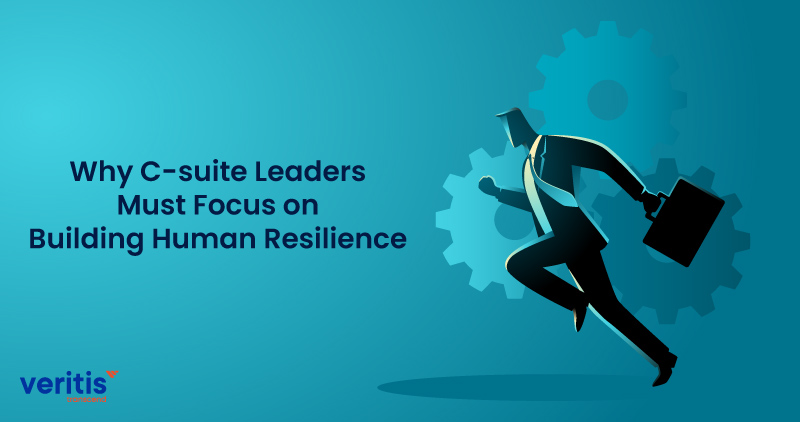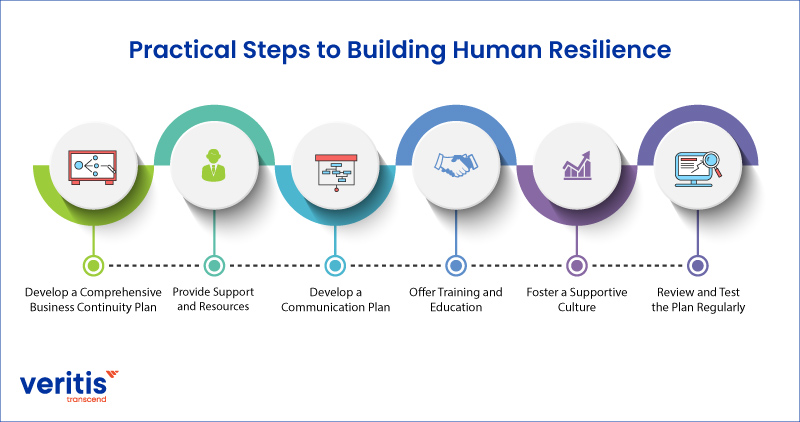
In today’s fast-paced business environment, unexpected events can occur at times, posing significant organizational challenges. These events, such as natural disasters, cyber-attacks, pandemics, or social unrest, can significantly impact businesses, disrupting operations and causing financial losses. Therefore, organizations must have a robust business continuity plan to ensure that they can continue operating in the face of disruption.
A business continuity plan is a comprehensive management system designed to ensure an organization can function during and after a crisis. C-suite leaders are critical in building human resilience within their organizations, enabling employees to cope with unexpected events and safeguarding the organization’s long-term survival. This article will explore how C-suite leaders can build human resilience within their organizations through effective business continuity planning.
Business continuity management is a crucial aspect of modern businesses. It refers to an organization’s ability to maintain its essential functions and processes during unforeseen circumstances. Business continuity planning (BCP) is developing strategies and plans to ensure an organization can continue functioning in a crisis. C-suite leaders play a critical role in business continuity planning by providing the necessary resources and support to mitigate risks and build resilience.
Business continuity planning is about more than just technology and infrastructure. C-suite leaders must also focus on building human resilience to ensure employees can cope with the impact of disruptive events. In this blog post, let’s explore the importance of building human resilience in business continuity planning and provide practical steps that C-suite leaders can take to ensure their employees are prepared for any unexpected event.
How Vulnerable Are U.S. Businesses to Disruptions?
- 74% of companies experienced a data breach in the past year—underscoring the need for proactive measures. Yet, only 30% have a formal business continuity plan, leaving a significant portion vulnerable to potential disruptions.
- Studies show that 80% of companies experiencing a significant disaster shut down within three years, and 93% that lack a recovery strategy fail after a major data loss event.
- In the U.S., 62% of organizations recognized the need for improvement and increased their continuity budgets in 2025, and 70% now have formal Business Continuity Plans (BCPs) in place. This growth in Business Continuity Plans (BCPs) is a positive step toward a more resilient business landscape.
Why C-suite Leaders Must Focus on Building Human Resilience

Business continuity risks can take many forms, and the impact can positively impact an organization. In the face of such events, employees may feel stressed, anxious, and uncertain. This can harm their ability to work effectively, leading to decreased productivity, lower morale, and increased turnover. C-suite leaders must recognize the importance of human resilience in the face of such events.
Building human resilience involves equipping employees with the tools and resources to cope with unexpected situations, manage stress, and maintain their mental and physical health. Resilient employees can better adapt to change and help the company weather any storm. By building resilience, C-suite leaders can ensure that their employees are better prepared to cope with unexpected events and can continue to perform their roles effectively. To achieve this, business restructuring consultants can play a crucial role in advising organizations on how to adapt their structure, policies, and processes to support employee well-being while ensuring continued business operations.
Let’s dive into the advantages and disadvantages of business continuity
Advantages:
- Reduces the Impact of Unexpected Events: By having a robust business continuity plan, organizations can minimize the impact of unexpected events on their operations, finances, and reputation. The plan outlines strategies to mitigate risks and provides a framework for responding to crises, ensuring the organization can continue operating despite disruption.
- Increases employee morale and engagement: Building human resilience within an organization can help to increase employee morale and engagement. Employees who feel supported and equipped to cope with unexpected events are more likely to be satisfied with their jobs and committed to the organization’s success.
- Enhances Organizational Reputation: Organizations that are well-prepared for unexpected events are viewed as more reliable and trustworthy by stakeholders. This can enhance the organization’s reputation and make it more attractive to customers, investors, and employees.
- Provides a Competitive Advantage: Organizations with a robust business continuity plan are better positioned to compete in their industry. They are more resilient and able to adapt to change, making them more likely to succeed in the long term.
Useful link: How C-Suite Executives Look at DevOps?
Disadvantages:
- Can be Costly: Developing and implementing a comprehensive business continuity plan can be expensive, especially for small or medium-sized organizations with limited resources.
- Can be Time-consuming: Building human resilience within an organization requires time and effort from employees and C-suite leaders. This can be a significant investment of time and resources, taking away from other critical business functions.
- May Create Complacency: If employees become too reliant on the business continuity plan, they may become complacent and less responsive to unexpected events. This can undermine the plan’s effectiveness and increase the organization’s vulnerability to disruption.
- May not Cover All Risks: No business continuity plan can cover every possible risk an organization may face. The plan may not account for unexpected events or challenges, leaving the organization vulnerable to disruption.
What Are the Practical Steps to Building Human Resilience?

1) Develop a Comprehensive Business Continuity Plan
The first step in building human resilience is to develop a comprehensive business continuity plan. This plan should identify potential risks and threats to the organization and outline strategies and plans to mitigate those risks. It should also include employee safety and well-being provisions during and after a crisis. C-suite leaders should involve employees in developing the plan to ensure it is comprehensive and practical.
Business Restructuring can play a critical role in this process, as it helps organizations realign their structure and resources to respond effectively to crises. Business leaders may need to restructure operations to ensure continuity and safeguard employee well-being while maintaining organizational performance during disruptions.
Business continuity planning and building human resilience within organizations have several advantages and disadvantages. C-suite leaders must carefully consider these factors when developing and implementing their business continuity plans to ensure they are effective and appropriate for their organization’s needs.
2) Provide Support and Resources
C-suite leaders must recognize that employees may need additional support during a crisis. This may include access to counseling services, financial assistance, and flexible work arrangements. By providing these resources, employees can feel more secure and supported during challenging times. In addition, C-suite leaders should ensure that employees have access to the necessary tools and equipment to continue to perform their roles remotely if required.
3) Develop a Communication Plan
Communication is vital during any crisis. C-suite leaders must develop a communication plan that ensures employees are updated with the latest information. This may include regular updates via email, social media, or the company intranet. Ensuring that employees have access to accurate and timely information is essential to help alleviate any anxiety or uncertainty. C-suite leaders should also ensure employees know the organization’s plans and procedures for dealing with a crisis.
4) Offer Training and Education
Training and education can help employees build the skills and knowledge they need to cope with unexpected events. This may include emergency procedures, first aid, and mental health awareness training. By providing employees with the tools they need to manage stress and maintain their well-being, C-suite leaders can help build resilience in their workforce. In addition, regular training and education can help employees feel more confident and prepared to deal with unexpected events.
5) Foster a Supportive Culture
C-suite leaders must foster a supportive culture that encourages open communication and collaboration. Employees should feel comfortable discussing their concerns and asking for help when needed. C-suite leaders should also be approachable and responsive to employee needs, providing a supportive environment that promotes well-being and mental health.
6) Review and Test the Plan Regularly
Finally, C-suite leaders should regularly review and execute their business continuity program to ensure it remains practical and current. This may involve simulations of various crisis scenarios to test the organization’s response and identify areas for improvement. Regular testing and review can ensure that employees are prepared for any unexpected event and that the organization can continue functioning in the face of disruption.
Useful link: Why Data Driven Culture is Important for You
How Big is the Business Continuity Software Market?
- Global BCP software is growing from $1.2 billion (2023) to $3.5 billion by 2032 (~12.5% CAGR).
- North America leads with a share of ~30.8%, and the U.S. market is growing at an 11% compound annual growth rate (CAGR).
- The broader BCP program solutions market is projected at $8.1 billion in 2023, rising to $21 billion by 2033 (9.8% CAGR).
What Are the 6 Foundational Steps for Human-Centric Business Continuity?
1) Assess Risk and Plan Strategically
Why it matters: Without structured planning, organizations often operate in a reactive mode during a crisis.
- Only 48% of U.S. organizations have a centralized resilience function, which means over half rely on fragmented or reactive approaches to continuity.
- 51% update their business continuity plans annually, while only ~23% do it more frequently, often not frequently enough in today’s rapidly changing risk landscape.
- Fewer than 40% of companies conduct real-time risk scenario testing, leaving leaders exposed to blind spots.
Action Point for the C-Suite:
- Appoint a Chief Resilience Officer or integrate business continuity directly under the COO or CRO.
- Use dynamic BIAs (Business Impact Analyses) quarterly, not annually.
- Integrate BCP with ERM (Enterprise Risk Management) to align operational and reputational risks.
2) Invest in People First
Why it matters: Human resilience is the frontline defense against disruption, yet it is often underfunded.
- 80% of large U.S. companies now offer employee wellness and assistance programs (EAPs), recognizing the strategic need to protect mental health.
- Post-COVID, flexible work is no longer a perk but a resilience strategy. According to International SOS, organizations with strong mental health support reported faster recovery and lower attrition during crises.
Action Point for the C-Suite:
- Budget for scalable wellness programs—mental health stipends, flexible schedules, burnout mitigation support.
- Partner with healthcare and HR vendors to embed mental resilience in core BCP planning.
- Treat burnout and turnover risk as key indicators of business continuity.
3) Communicate Transparently & Often
Why it matters: During a crisis, communication can make or break trust, productivity, and morale.
- Gallup reports that only 30% of U.S. employees feel aligned with their organization’s mission or direction.
- In high-stress situations, a lack of information causes greater anxiety than bad news.
Action Point for the C-Suite:
- Create a crisis communication playbook with layered channels (e.g., email, Slack, SMS, intranet).
- Establish a real-time internal dashboard for continuity alerts and updates.
- Encourage upward feedback and “pulse checks” to assess morale and comprehension.
4) Train, Educate & Simulate
Why it matters: When a crisis hits, preparation defines performance.
- Only 39% of employees receive regular training on business continuity plans.
- Simulations, including those for remote work readiness, cybersecurity breaches, and supply chain breakdowns, help organizations identify latent weaknesses before disasters strike.
Action Point for the C-Suite:
- Mandate role-specific BCP training for all functions, especially the frontline, IT, and leadership.
- Conduct at least two full-scale crisis simulations annually; use AI to model edge-case scenarios.
- Include “soft-skill resilience” (e.g., stress management, emotional intelligence) in executive education programs.
5) Build a Supportive Culture
Why it matters: Culture determines whether employees will lean in or check out during adversity.
- The Financial Times and Deloitte note that toxic leadership behaviors and poor communication are top predictors of employee burnout, not just workload or job complexity.
- Cultures that prioritize empathy, listening, and transparency recover faster and retain top talent during crises.
Action Point for the C-Suite:
- Embed “psychological safety” into leadership development programs.
- Audit middle management for cultural alignment and adaptability.
- Recognize and reward resilience-oriented behaviors (e.g., initiative during disruptions).
6) Review & Iterate Continuously
Why it matters: Plans that aren’t tested and adapted fail when needed most.
- 72% of U.S. businesses conduct Business Impact Analyses (BIAs), but only 44% perform internal audits, and 35% undergo third-party reviews, exposing them to unseen vulnerabilities.
- Crisis environments evolve (e.g., new cyber threats, regulatory changes, labor shortages), so static plans quickly become obsolete.
Action Point for the C-Suite:
- Build a quarterly “Resilience Review” cadence into executive dashboards.
- Commission an external audit or red-team test of your BCP at least once per year.
- Assign accountability to a business continuity governance committee reporting to the board.
Case Study: BI‑Powered IT Modernization Enhances Business Resilience
A prominent real estate firm looking to fortify business continuity and enable data-led decision-making partnered with Veritis to modernize its IT infrastructure with integrated business intelligence (BI) tools.
Challenge:
Legacy systems siloed critical data, delaying risk detection and reducing agility. This hindered the firm’s ability to respond quickly to operational disruptions and maintain stakeholder trust.
Veritis’ Solution:
- Implemented a centralized ETL-driven data warehouse feeding into Power BI dashboards for unified reporting
- Deployed real-time monitoring with automated alerts to flag anomalies early
- Built a cloud-resilient architecture with scheduled backups and disaster recovery protocols
Impact:
- 40% faster risk-response time thanks to real-time insights
- Enhanced proactive issue management via automated BI alerts
- Secure, off‑site backups ensured data integrity and availability
- Streamlined reporting improved confidence among stakeholders
Read the complete case study: Building Real Estate IT Business Infrastructure with BI Analytics.
Conclusion
Business continuity planning is essential for any modern organization. C-suite leaders are critical in ensuring their organization is prepared for unexpected events. Building human resilience is a crucial aspect of business continuity planning. C-suite leaders must recognize the importance of equipping employees with the necessary tools and resources to cope with disruption. By developing a comprehensive business continuity plan, providing support and resources, developing a communication plan, offering training and education, fostering a supportive culture, and regularly reviewing and testing the plan, C-suite leaders can help build a resilient workforce that can help their organization weather any storm. But this planning and execution need empathy at its heart.
With empathy as one of its tenets, Veritis has chalked out business restructuring services that have allowed companies to continue their business operations in the face of the pandemic. Whether a Fortune 500 or emerging firm, we pulled out all the stops to ensure business continuity. We have won the Stevie Award for our contributions to DevOps and made our presence felt in the IT arena. Based out of Texas, we have catered to clients from around the globe. So, reach out to us, and we shall bring out a business continuity plan that has empathy and builds human resilience.
Got Questions? Schedule A Call
Also Read:
- 4 Core Principles For A ‘Perfect Business Continuity Plan’
- 4 Core Principles For A ‘Perfect Business Continuity Plan’
- Steps to Preserve Business Continuity and Enterprise Resilience
- Business Continuity: Steps To ‘Restart’ Your Stalled Operations!
- 7 Key Containerization Benefits for Your IT Business
- Data Security in the Cloud Solutions Every Modern Business Needs